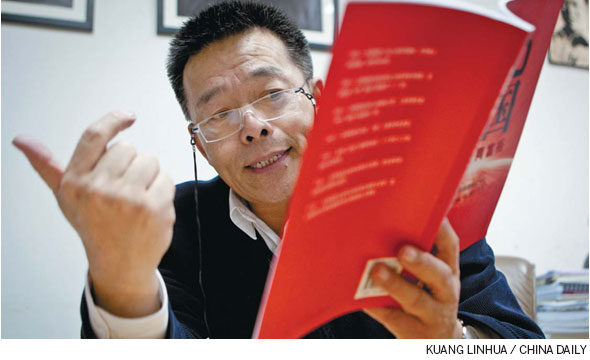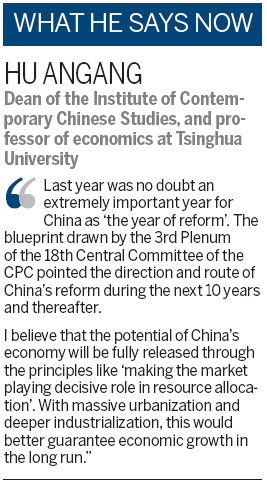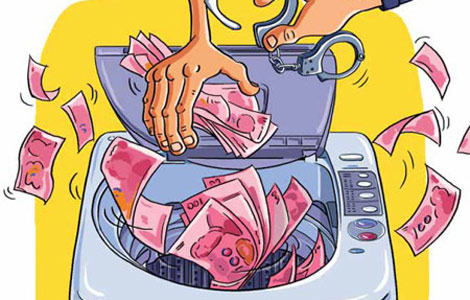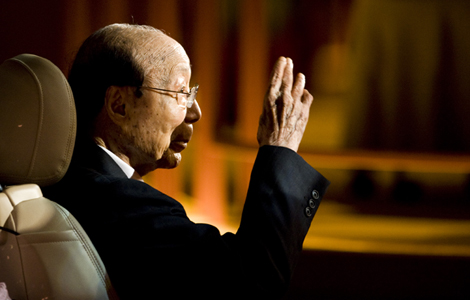Real potential underestimated
Updated: 2014-01-17 09:27
(China Daily Europe)
|
|||||||||||

Effective state planning, industrial innovation and modernization of infrastructure are important growth engines for China, says academic
This story was originally published on May 3, 2013
While many economists look to when the Chinese economy will become bigger than the United States, Hu Angang is more ambitious.
The 60-year-old Chinese economist predicts the Chinese economy will be double the size of that of the US by 2030 - and also bigger than the US and Europe put together. He makes his forecast in his book, China 2030.
As the most optimistic projection yet about the Chinese economy, it is likely to provoke major worldwide interest.
Hu, who is dean of the Institute of Contemporary Chinese Studies, one of China's leading think tanks, and professor of economics at Tsinghua University, believes the Chinese economy has been underestimated.
"I think most foreign experts underestimate China in almost every aspect such as the number of highly educated people, its strength in technology and in research and development. I think because of this the US and countries in the European Union haven't been able to respond to China's rise," he says.
In an academic career that has also taken in spells at Japanese universities and Harvard, Hu has become one of China's leading economists and the author of as many as 60 books.
He says there are a number of engines to China's growth, including effective state planning (under the government five-year plan system), industrial innovation and the modernization of infrastructure such as the development of high-speed railways among other factors.
"The dynamic interaction between all these engines has and is delivering economic growth. At least 99 percent of economists have underestimated their impact on China's GDP growth. I am of the 1 percent who didn't do that," he says.
Hu, a keen ping pong player and lover of Mozart, is well known as a defender of China's economic system and does not advocate that China's future economic success relies on market-led reforms and the privatization of its state-owned enterprises, something espoused by many of his fellow Chinese economists.

"It is the wrong way to go for China to privatize its state-owned enterprises. The private sector should develop but it should compete against the state sector and not replace it," he says.
Hu points out that China's state-owned enterprises are not inefficient leviathans - as some argue - but are becoming increasingly dominant on the world stage against today's great corporations.
He says that China had only one company listed in the Fortune 500 compared with the US' 164 in 1990, but by 2012, while the US tally had declined to 162, China had 70, 64 of which were state-owned. Significantly also, only 64 companies from Japan made the 2012 list, fewer than China's total, he points out.
"It is these large companies that are driving the national GDP. So I say Japan's sun is going down, China's sun is rising," he says.
Unlike many economists, Hu does not expect China's economy to slow down any time soon.
While others believe China will find it difficult to maintain current growth levels in the 2020s when much of the country's new infrastructure will be built and the economy matures, Hu believes it will find new momentum.
"From 2011 to 2030, I think growth will still be around 7.5 percent and that level of growth over a 19-year period will result in China having an economy double the size of the US."
He says China's potential to surpass the US can be quantified by just looking at fundamental raw data.
"China and the US have roughly the same land area but China's population is between four and five times as big. China's labor force is 780 million, while that of the US is just 153 million," he says.
"China also has some 300 million farmers in its agricultural sector whereas the US probably has around 3 million. And although the number of people in the workforce with higher education is roughly equal at 120 million, in research and development. China devotes 3 million person-years, whereas the US does just half of that."
Hu certainly does not envisage any scenario such as in Japan, which has had two decades of minimal growth.
He says the weakness of Japan has been its politicians looking for short-term solutions to its problems.
"Chinese politicians think differently. Like Chairman Mao (Zedong), Deng Xiaoping or Jiang Zemin, they think about what happens in 70 years or even longer. The economic planning in China can avoid the Japanese scenario."
In his book, he argues the world is currently enjoying the "third global age" of growth, which many in the US and Europe might find difficult to believe.
He says this is largely because of the rise of China and India, which he argues will drive the global annual growth between 1990 and 2030 to 3.5 percent.
This is above the 2.1 percent of the first golden age from 1870 to 1913 and slightly below the 4.9 percent of the second between 1950 and 1973.
What is perhaps more significant is the shift in global economic dominance between the North (the US and the EU as well as Japan) and the South (defined as the Asian developing nations as well as Russia and Brazil).
The South will have 66.9 percent of global GDP in 2030, compared with the North's 33.1 percent. This is marked contrast to 1973 when the position was almost reversed with the North having a 60.1 percent share and the South just 39.9 percent.
"Since 1973, step by step, the global share of the South has increased largely driven by the reforms that have taken place in China and India. Last year was the first time the southern nations have taken over. What we are seeing in this century is the big convergence," he says.
Hu was born in Anshan in Liaoning province and is named after the local steel company, Angang, which was a popular style during a period when steel production was the central focus.
His academic progress was delayed by the "cultural revolution" (1966-76) when he was sent to work on a state-owned farm in Heilongjiang province.
He originally studied to be an engineer but switched to economics after doing population and development analysis for his PhD.
Hu has taught at Keio University in Japan and Harvard University and is currently a research fellow at the Massachusetts Institute of Technology.
But it is in his prominent position in Chinese think tanks and in advising those formulating China's economic policy for which he is best known.
He worked as chief editor for China Studies Report, which is a reference for senior officials, and he also directed the Center for China Study, another leading think tank.
Hu is an admirer of the late British economist Angus Maddison, who he met in France and who had his own method of calculating GDP. On the Maddison measure, China became a bigger economy than the US in 2009. He uses the standard nominal GDP data to make his latest predictions, however.
"The standard measures place a higher value on service industries and not enough on the physical economy. The physical economy in China, including manufacturing and agricultural sectors, is three times that of the US. That is why I prefer Maddison assumptions," he says.
Although Hu is predicting China's GDP to be double that of the US, he is making no such forecast about per capita income and Chinese citizens achieving the same money value standard of living as Americans.
He insists per capita income is not a reliable indicator and prefers to use other measures such as life expectancy and education comparators.
In 2030, he points out, the Chinese people will on average spend 12.5 years in education, compared to 12 years in the US. Life expectancy will also be 80 years in China in 17 years time compared to 81.7 years in the US, according to his data.
"We don't really care about per capita GDP. We care about how to catch up with the US in terms of life expectancy, education and healthcare. The thing about per capita GDP is that it looks good on the outside but is not a crucial indicator of the well being of the people of the country," he says.
(China Daily European Weekly 01/17/2014 page8)
Today's Top News
Xi writes to Chinese in German colleges
China software to rival Android
Will China dominate the world?
Mainland policy lures HK students
Obama tells Germans he will not wiretap
Party is over for SOEs conferences
Egypt referendum wins support
Home prices continue to climb
Hot Topics
Lunar probe , China growth forecasts, Emission rules get tougher, China seen through 'colored lens', International board,
Editor's Picks

|

|

|

|

|

|





